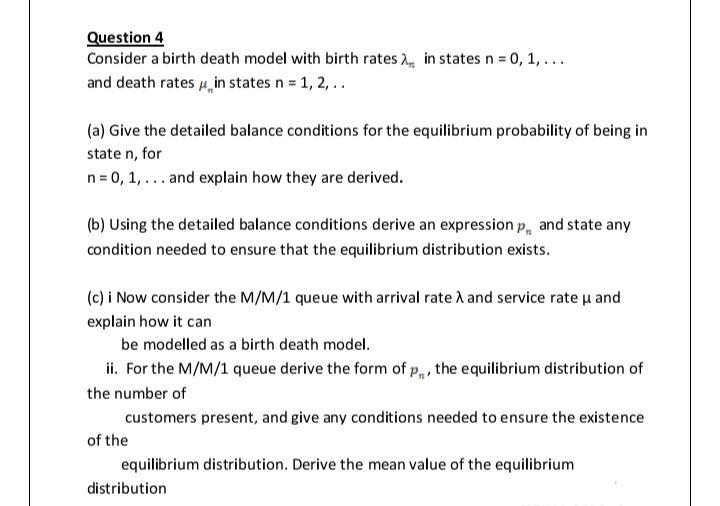Question 4 Consider a birth death model with birth rates A, in states n = 0, 1, ... and death rates 4, in states n = 1, 2, .. (a) Give the detailed balance conditions for the equilibrium probability of being in state n, for n= 0, 1,... and explain how they are derived.
Question 4 Consider a birth death model with birth rates A, in states n = 0, 1, ... and death rates 4, in states n = 1, 2, .. (a) Give the detailed balance conditions for the equilibrium probability of being in state n, for n= 0, 1,... and explain how they are derived.
Functions and Change: A Modeling Approach to College Algebra (MindTap Course List)
6th Edition
ISBN:9781337111348
Author:Bruce Crauder, Benny Evans, Alan Noell
Publisher:Bruce Crauder, Benny Evans, Alan Noell
Chapter5: A Survey Of Other Common Functions
Section5.6: Higher-degree Polynomials And Rational Functions
Problem 5E: Population Genetics In the study of population genetics, an important measure of inbreeding is the...
Related questions
Topic Video
Question
Please answer only the Question C. Thank you

Transcribed Image Text:Question 4
Consider a birth death model with birth rates A, in states n = 0, 1, ...
and death rates 4, in states n = 1, 2, ..
(a) Give the detailed balance conditions for the equilibrium probability of being in
state n, for
n= 0, 1, ... and explain how they are derived.
(b) Using the detailed balance conditions derive an expression p, and state any
condition needed to ensure that the equilibrium distribution exists.
(c) i Now consider the M/M/1 queue with arrival rate i and service rate u and
explain how it can
be modelled as a birth death model.
ii. For the M/M/1 queue derive the form of p„ , the equilibrium distribution of
the number of
customers present, and give any conditions needed to ensure the existence
of the
equilibrium distribution. Derive the mean value of the equilibrium
distribution
Expert Solution
This question has been solved!
Explore an expertly crafted, step-by-step solution for a thorough understanding of key concepts.
Step by step
Solved in 2 steps with 4 images

Knowledge Booster
Learn more about
Need a deep-dive on the concept behind this application? Look no further. Learn more about this topic, statistics and related others by exploring similar questions and additional content below.Recommended textbooks for you

Functions and Change: A Modeling Approach to Coll…
Algebra
ISBN:
9781337111348
Author:
Bruce Crauder, Benny Evans, Alan Noell
Publisher:
Cengage Learning

Algebra & Trigonometry with Analytic Geometry
Algebra
ISBN:
9781133382119
Author:
Swokowski
Publisher:
Cengage


Functions and Change: A Modeling Approach to Coll…
Algebra
ISBN:
9781337111348
Author:
Bruce Crauder, Benny Evans, Alan Noell
Publisher:
Cengage Learning

Algebra & Trigonometry with Analytic Geometry
Algebra
ISBN:
9781133382119
Author:
Swokowski
Publisher:
Cengage
